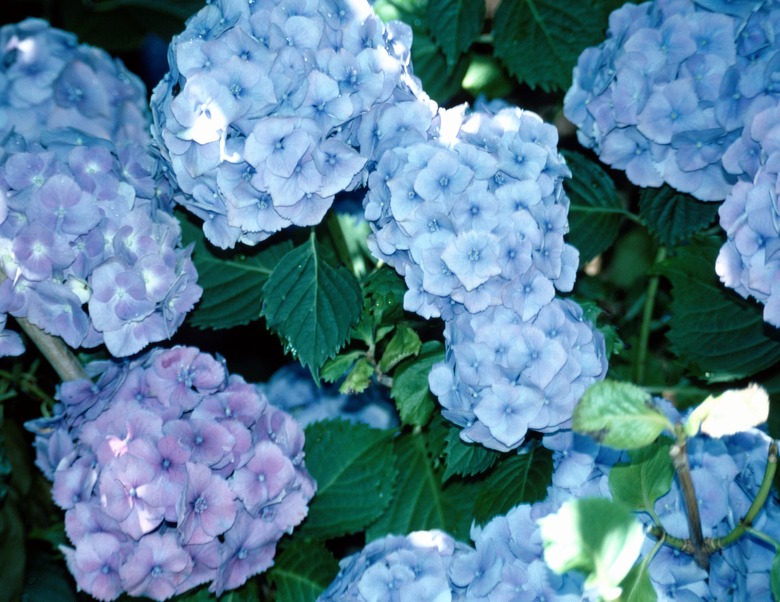How To Fertilize Hydrangeas With Miracle-Gro
Hydrangeas are flowering shrubs that put forth large, showy blooms during the summer. Gardeners who want robust and healthy hydrangeas must focus on providing enough sunshine and water for their plants. It's also important to prune hydrangeas after they blossom so that the shrubs can develop next year's flower buds. Hydrangeas also require fertilization to thrive; however, they don't require special fertilization. All-purpose Miracle-Gro fertilizer is well suited for hydrangeas.
Step 1
Mix the Miracle-Gro fertilizer with water according to package instructions for the size of your hydrangea shrubs.
Step 2
Apply the Miracle-Gro fertilizer every other time you water, about every two to three weeks. Pour it onto the soil under the shrub, being careful not to get any fertilizer on the foliage. Doing so could burn the tender leaves and blossoms. Immediately rinse off any splashes.
- Hydrangeas are flowering shrubs that put forth large, showy blooms during the summer.
- It's also important to prune hydrangeas after they blossom so that the shrubs can develop next year's flower buds.
Step 3
Generously water the shrubs immediately after fertilizing to prevent the fertilizer from burning the uppermost roots of the shrub.
Hydrangeas
Designate a planting site with organically rich, well-drained soil. Spade or rotary-till the amendment into the soil for even incorporation. If you're uncertain about when to irrigate, water when the top 3 or 4 inches of soil is dry to the touch. Sprinkle a balanced, 10-10-10 granular fertilizer on top of the soil in March and May and after the hydrangeas flower. Frequent, severe pruning results in weaker plants. Leaf-spot fungi cause purple-margined, gray or brown lesions. Removing and destroying infested plant parts controls powdery mildew. Raking up fallen, diseased foliage and putting down a 3- to 4-inch layer of organic mulch prevents leaf-spot spores from splashing the shrubs.
- Designate a planting site with organically rich, well-drained soil.
- Raking up fallen, diseased foliage and putting down a 3- to 4-inch layer of organic mulch prevents leaf-spot spores from splashing the shrubs.
Hydrangeas
Designate a planting site with organically rich, well-drained soil. Spade or rotary-till the amendment into the soil for even incorporation. If you're uncertain about when to irrigate, water when the top 3 or 4 inches of soil is dry to the touch. Sprinkle a balanced, 10-10-10 granular fertilizer on top of the soil in March and May and after the hydrangeas flower. Frequent, severe pruning results in weaker plants. Leaf-spot fungi cause purple-margined, gray or brown lesions. Removing and destroying infested plant parts controls powdery mildew. Raking up fallen, diseased foliage and putting down a 3- to 4-inch layer of organic mulch prevents leaf-spot spores from splashing the shrubs.
- Designate a planting site with organically rich, well-drained soil.
- Raking up fallen, diseased foliage and putting down a 3- to 4-inch layer of organic mulch prevents leaf-spot spores from splashing the shrubs.
Things Needed
- Miracle-Gro fertilizer
- Watering can
Tip
If you are concerned about low acidity in your soil, fertilize with Miracle-Gro's Miracid once per week during the growing season. Miracid is a soil acidifier that helps boost soil acidity. Generously water hydrangea shrubs immediately after fertilizing with Miracid to prevent the fertilizer from burning the uppermost roots of the shrubs. Miracid also helps encourage hydrangea blossoms to bloom blue.
References
- Texas A&M ExtensionAggie Horticulture: Hydrangea
- Fine Gardening: Hydrangea Arborescens "Annabelle"
- Monrovia: "Golden Crane" Hydrangea
- 1979 Sunset New Western Garden Books; David E. Clark
- University of California Cooperative Extension: How to Grow Hydrangeas in the San Joaquin Valley
- University of Massachusetts Center for Agriculture: Landscape, Agriculture & Urban Forestry Program — Growing Hydrangeas
- Clemson Cooperative Extension: Hydrangea
- University of California Cooperative Extension: Pruning Hydrangeas
- Fine Gardening: Hydrangea Paniculata
- Fine Gardening: Hydrangea Arborescens
- Monrovia: Endless Summer® Hydrangea
- Fine Gardening: Hydrangea Arborescens "Annabelle"
- Monrovia: "Golden Crane" Hydrangea
- 1979 Sunset New Western Garden Books; David E. Clark
- University of California Cooperative Extension: How to Grow Hydrangeas in the San Joaquin Valley
- University of Massachusetts Center for Agriculture: Landscape, Agriculture & Urban Forestry Program — Growing Hydrangeas
- Clemson Cooperative Extension: Hydrangea
- University of California Cooperative Extension: Pruning Hydrangeas
- Fine Gardening: Hydrangea Paniculata
- Fine Gardening: Hydrangea Arborescens
- Monrovia: Endless Summer® Hydrangea
